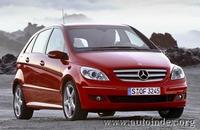2005 Geneva Motor Show: DaimlerChrysler Unveils New Fuel Cell Vehicle
- The new F-Cell is extending the family of fuel cell vehicles from DaimlerChrysler - More than ten years of the automotive fuel cell: DaimlerChrysler, the pioneer, is pressing ahead with development - The concept of the Compact Sports Tourer with sandwich floor is predestined for emission-free fuel cell drive
GENEVA, March 1 -- At the 2005 Geneva Motor Show, DaimlerChrysler, the pioneer of fuel cell drive, is presenting the next generation of its fuel cell vehicles. The new F-Cell, built on the Mercedes- Benz B-Class, is extending the family of fuel cell vehicles to the segment of sports tourers. The new F-Cell continues with the unique sandwich concept developed by Mercedes-Benz that makes it predestined for this type of drive unit.
Sporty, dynamic driving is reconcilable with emission-free operation, as is impressively demonstrated by the technical data: the high-torque electric motor will develop more than 100 kW -- 35 kW more power than its predecessor generation.
Thanks to a reduction in fuel consumption and a further enhanced storage capacity, the operating range has now been increased to almost 250 miles (400 km). The component reliability and longevity have also been further improved.
"With this car, we are continuing our highly successful practical tests on an even larger scale," said Dr. Thomas Weber, member of DaimlerChrysler's Board of Management with responsibility for Research and Technology and for the development of the Mercedes Car Group.
The DaimlerChrysler researchers and engineers have been working since 1990 towards automotive application of this technology. In 1994 the first fuel cell vehicle, NECAR 1, was presented; more than 20 other research vehicles and prototypes have since followed. The size and weight of the drive system have been considerably reduced, while the performance and reliability have been steadily enhanced. 180 patent applications in the field of fuel cell technology underscore the pioneering achievements of DaimlerChrysler. With the Mercedes-Benz B-Class F-Cell, a further significant milestone has been reached along the road to market maturity for the fuel cell.
In 2003, DaimlerChrysler launched the world's most extensive series of practical tests for the fuel cell in cars, vans and regular service buses. More than 100 fuel cell vehicles are currently in everyday application, providing DaimlerChrysler engineers with invaluable information for the ongoing development of this future-oriented technology. This involves optimization of the vehicles and their components, the establishment of an infrastructure, and the increased acceptance of hydrogen technology among drivers and passengers.
Since 2003, 30 Mercedes-Benz Citaro city buses with fuel cell drive have been on the move in regular route service in ten major European cities. Three buses are also in operation in, Perth Australia and another three will operate in Peking, China. These vehicles must prove their worth in the most varied of climatic conditions. The city buses alone have already covered more than 300,000 miles (500,000 km) and transported more than two million passengers, who have been convinced by the advantages of this quiet, emission-free technology. Several fuel cell powered Sprinter Vans also are currently being used in day-to-day delivery operations with dispatching companies in the United States and Germany.
Since late 2004, 60 Mercedes-Benz F-Cell's have been in operation with customers in the United States, Germany, Japan and Singapore. In this first test phase, approximately 190,000 miles (300,000 km) have already been covered under highly diverse conditions and documented with these vehicles.
In the long term, the fuel cell provides the best opportunities for securing uncompromisingly environment-friendly mobility for the automobile: the fuel cell runs on either pure hydrogen or hydrogen media, and is thus a genuine zero-emission power unit: electrical energy is released in a chemical reaction between the hydrogen and atmospheric oxygen to drive an electric motor. Moreover, the fuel cell has an efficiency factor approximately twice that of the internal combustion engine.
In order to focus expertise and resources, and to press ahead with the development of the fuel cell, DaimlerChrysler has entered into a strategic alliance with Ford Motor Company and the fuel cell specialist Ballard Power Systems. Partnerships are an important part of fuel cell technology development. DaimlerChrysler has the opportunity of sharing goals with other companies and government entities, such as UPS and the EPA. DaimlerChrysler and BP, partners in the Department of Energy's fuel cell vehicle and infrastructure validation program, recently dedicated the first hydrogen station in the plan. These partnerships and the common goal will propel fuel cell transportation to maturity.
The fuel cell is the key technology for emission-free driving of the future and is the long-term objective of DaimlerChrysler's five-stage Energy for the Future roadmap. DaimlerChrysler is continuing to optimize the internal combustion engine, since the potential of gasoline and diesel engines has by no means been exhausted. The aim is to reduce fuel consumption and exhaust emissions, while at the same time enhancing driving pleasure, power development and comfort. DaimlerChrysler is also committed to optimizing fuel quality worldwide and is supporting the fuel evolution from crude oil to largely CO2-neutral fuels derived from biomass. Hybrid drive is a significant interim solution along the road to emission-free mobility with the fuel cell.



